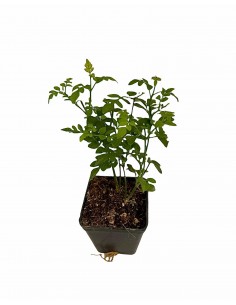Plant of Albizia
Generalities Albizia tree:
The genus Albizia (or albizzia) belongs to the large Fabaceae family (formerly Leguminosae), where we find about fifty species all spectacular plants both for their leaves and their flowers. They are plants native to subtropical Asia and are real trees reminiscent of Acacias, with umbrella-like foliage, erect stem that bears numerous very branched branches and with smooth bark that tends to wrinkle with age. In most of the Albizia species the leaves are deciduous, bipinnate, arranged alternately and are composed of numerous very small leaflets, without petiole
Online Sale Albero di Albizia, available in the following formats:
- jar 7cm, Height: 10 / 15cm
Online Sale Albero di Albizia, available in the following formats:
- jar 7cm, height 10/15cm
Generalities Albizia tree:
The genus albizia consists of small trees, widespread in Asia, Europe, Australia and North America; in Italy, the only species that is commonly cultivated is Albizia julibrissin, also known as acacia or mimosa in Constantinople, a very widespread species now throughout the globe, considered an invasive species in some areas. Albizia is a small tree, which usually does not exceed 5-6 meters in height, producing a thin erect stem on which a dense hemispherical crown spreads, very wide and dense; the leaves are large, pinnate, made up of small oval leaves, fall in autumn, and reappear in early spring. In late spring the albizie produce a spectacular flowering, their tiny flowers, characterized by having the corolla much shorter than the stamens, are gathered in tight clusters, which give rise to species of pink and yellow pom poms, half-shaped ball. At one time these trees were often confused with mimosas or even with acacias, with which they share many characteristics; in fact they have a certain kinship with both genera, being part of the fabaceae (legumes). As with all legumes, the seeds of albizia are also enclosed in thin siliques, such as those of beans or cercis, or long pods, which remain on the sapling for a long time. Albizia seeds are generally fertile, and it is not uncommon to find small specimens of albizia born from seed at the foot of adult treesi.
Albizia tree cultivation and care:
These small trees, very decorative, are completely rustic in Italy, and it is probably also for this reason that they have had great success in cultivation in the past. They are positioned in well-lit areas, with at least a few hours of direct sunlight every day. They tolerate frost very well, up to about -25 ° C, but also drought, wind, pollution, saltiness; in many Italian cities they have been used in street furniture. Newly planted saplings may need summer watering, certainly at the time of planting, but also later in the event of prolonged drought. We remind you that it is a tree that is not very large, but that produces a very enlarged crown, for this reason, at the time of implantation, we remember to position the tree where it can easily develop its crown, therefore at least a few meters away. from other trees or buildings.



















